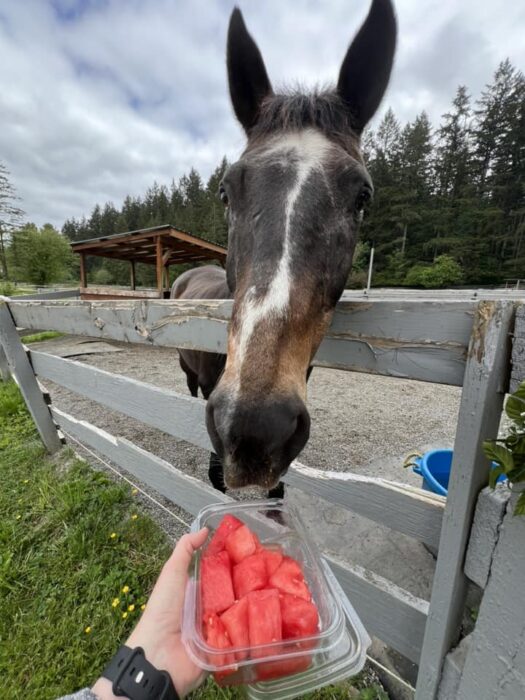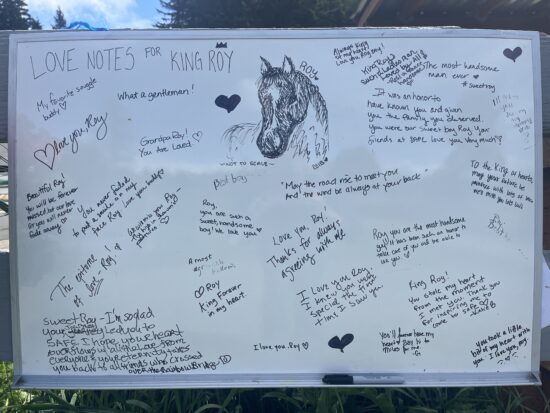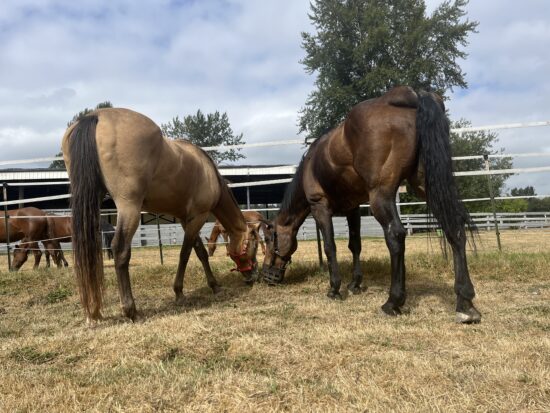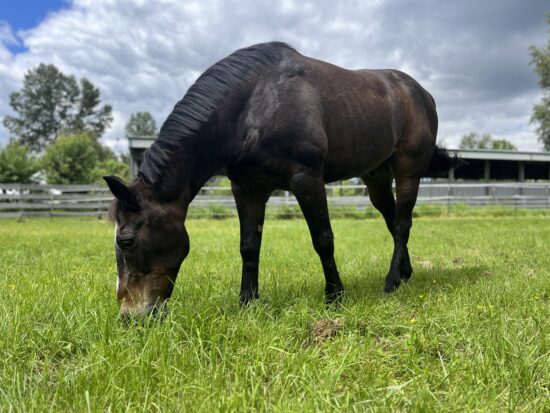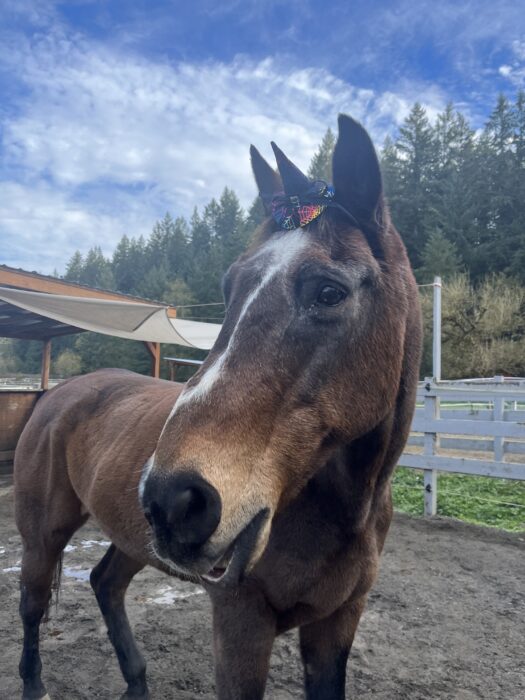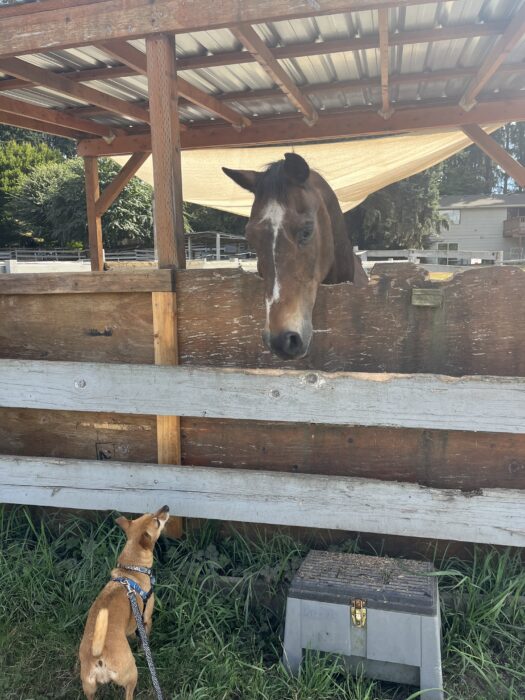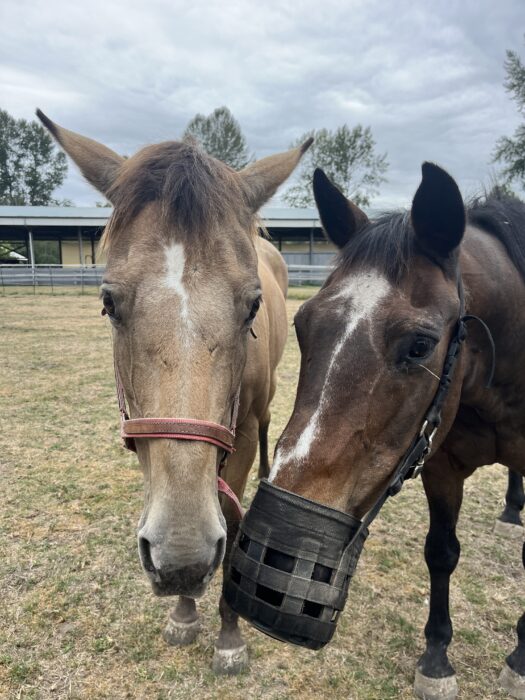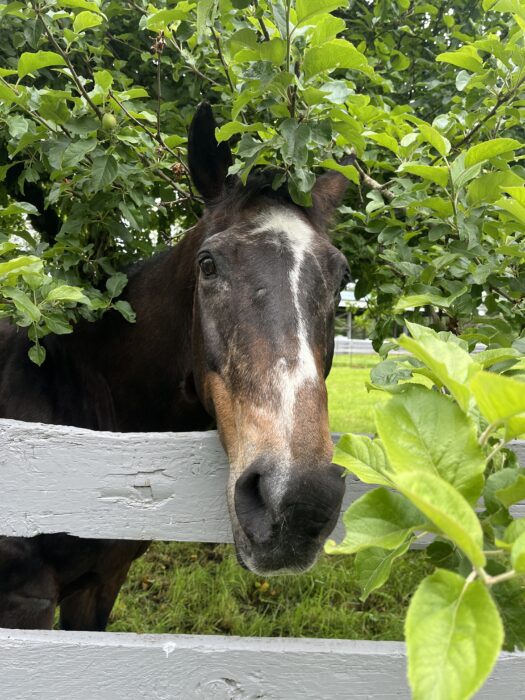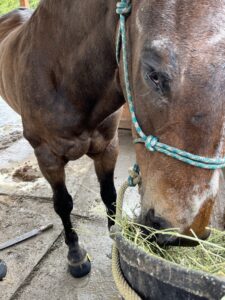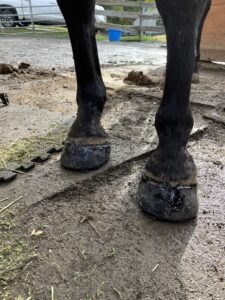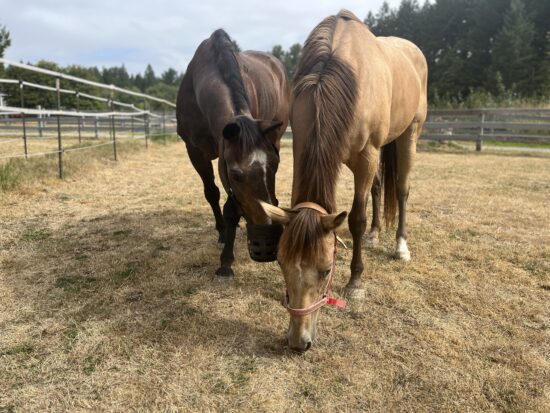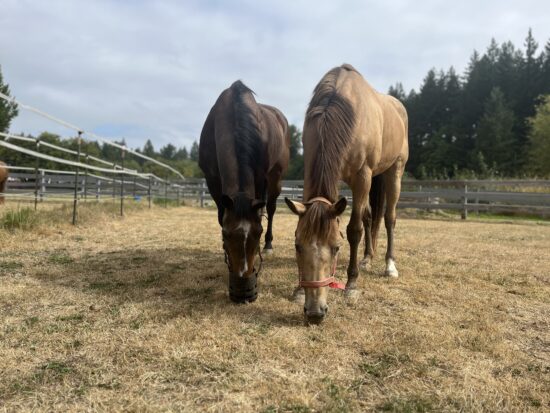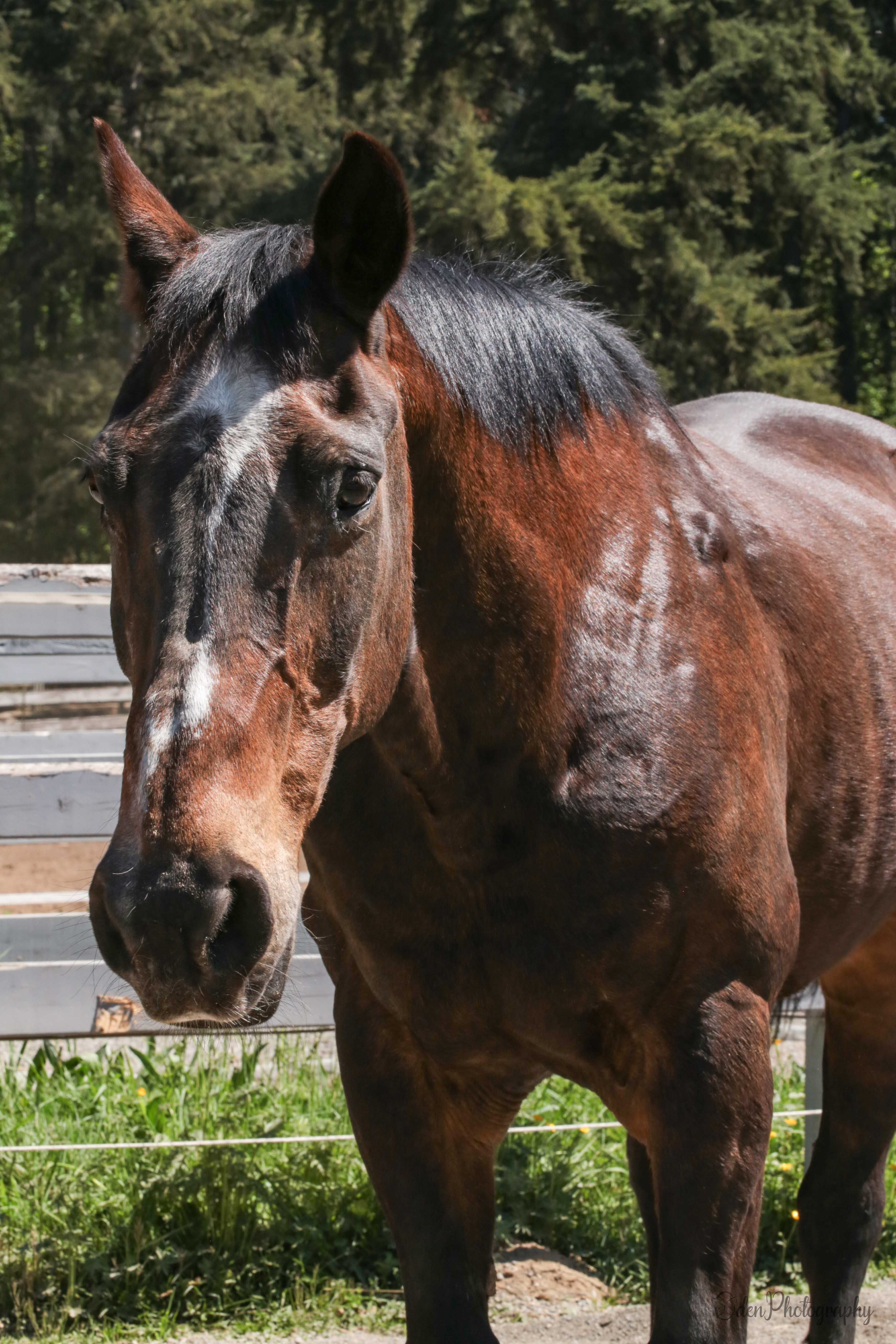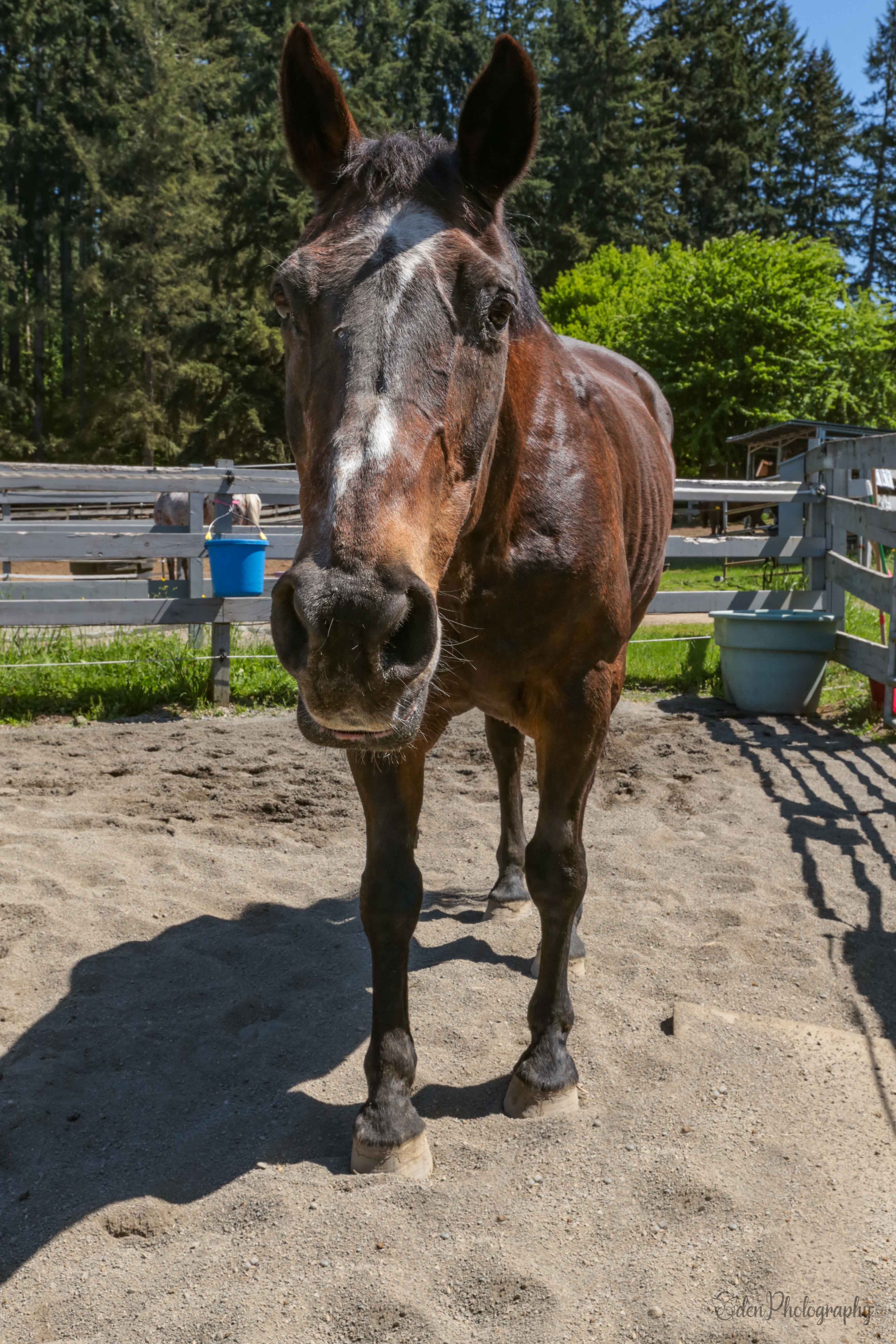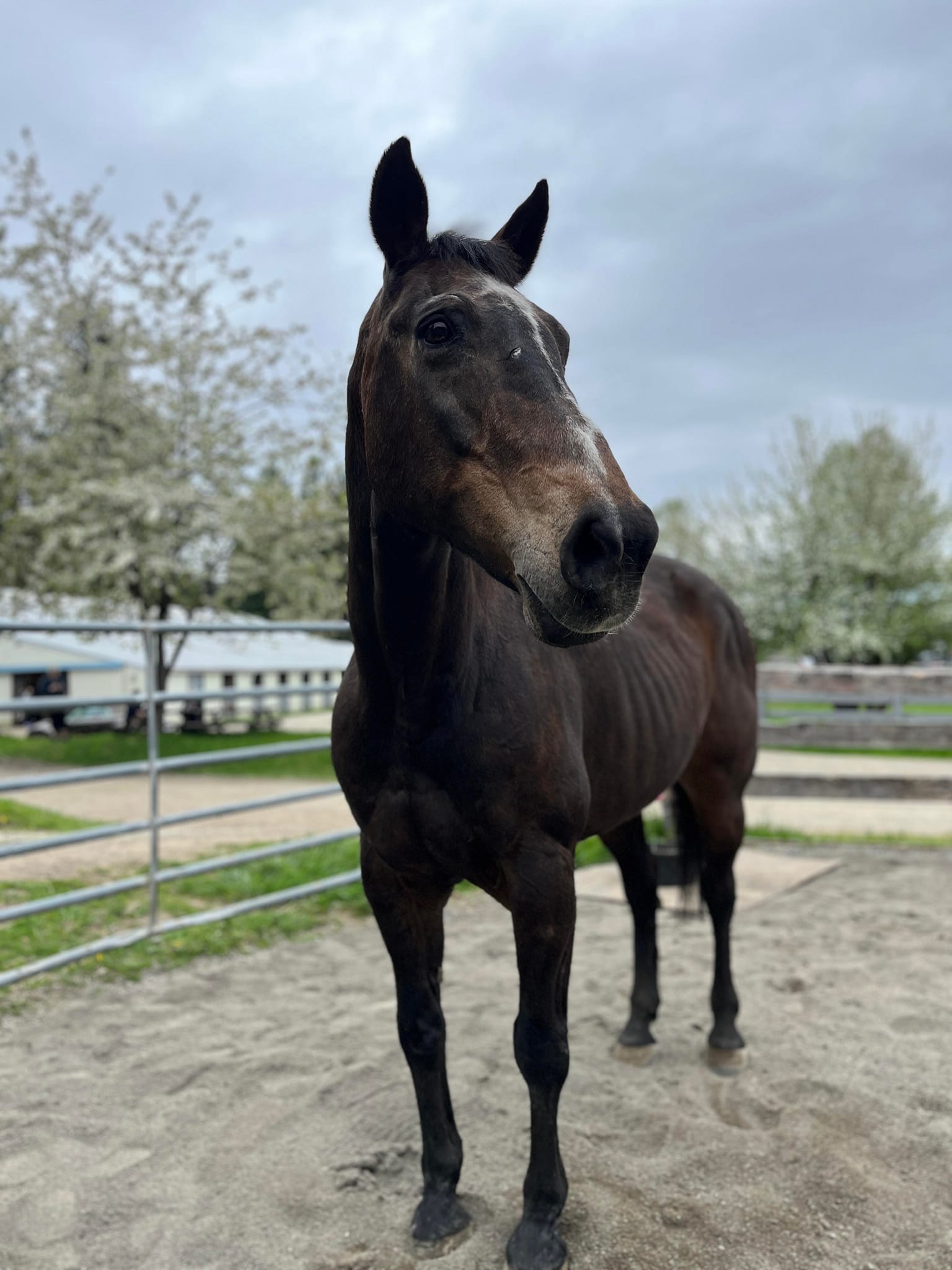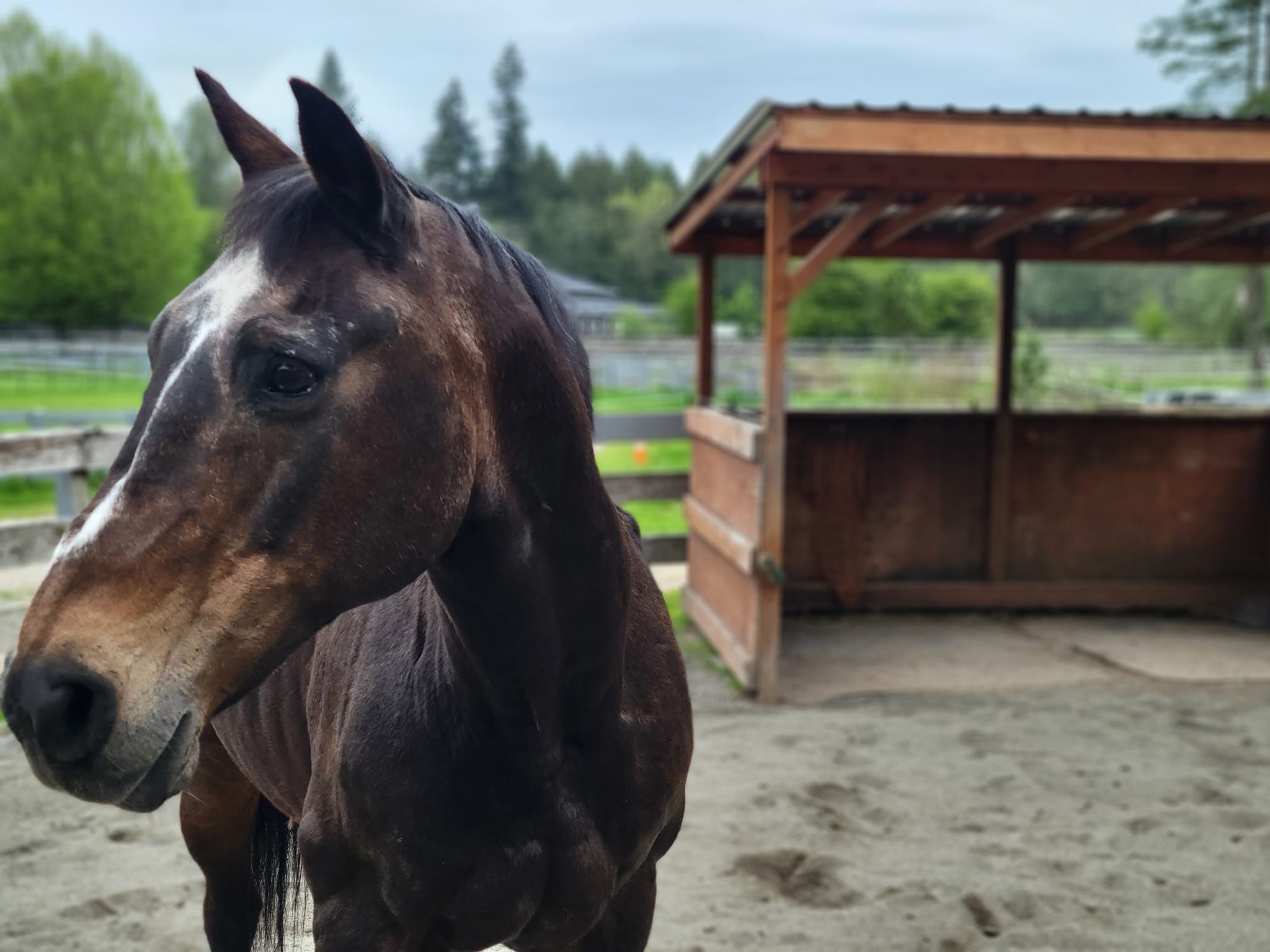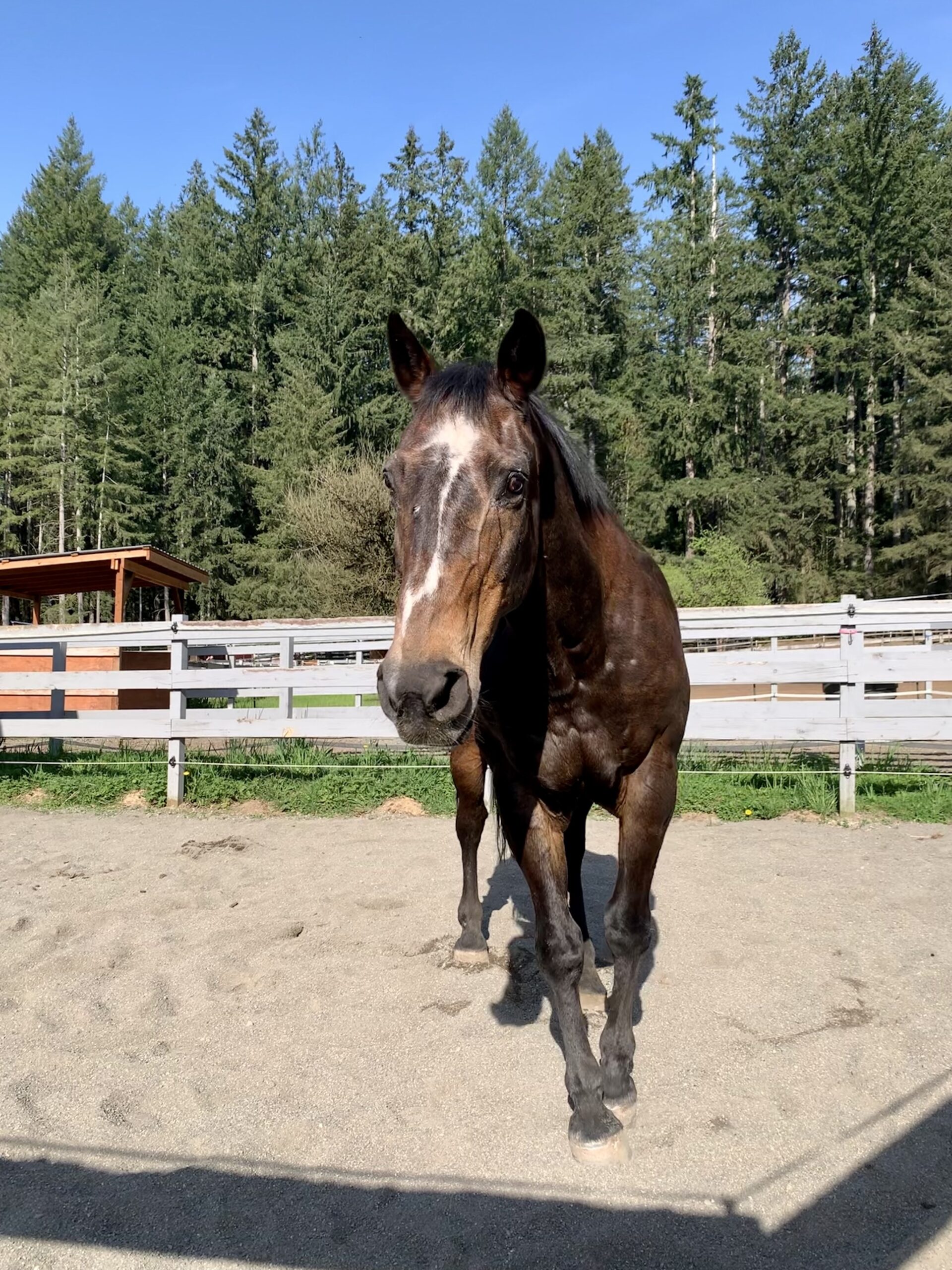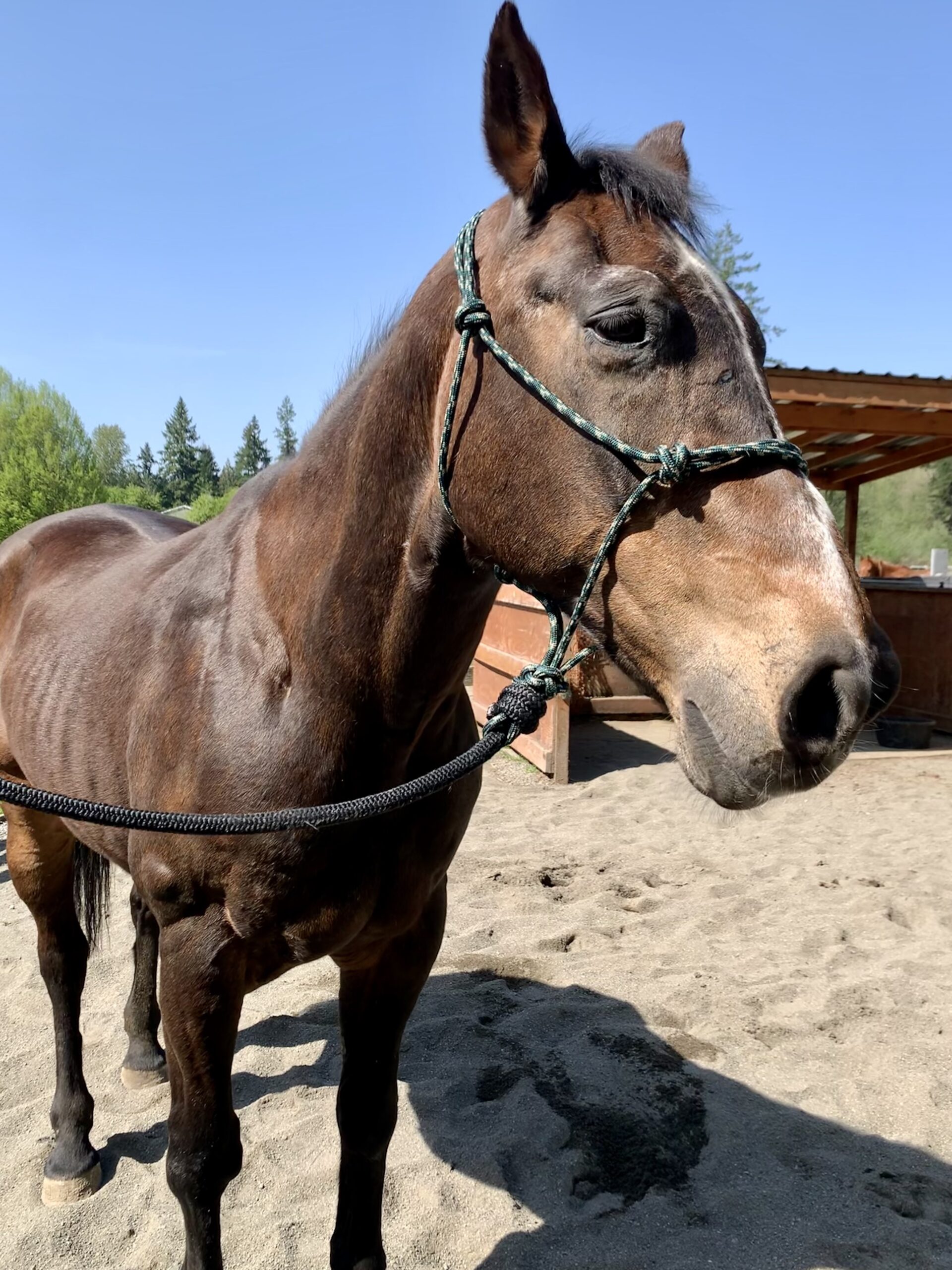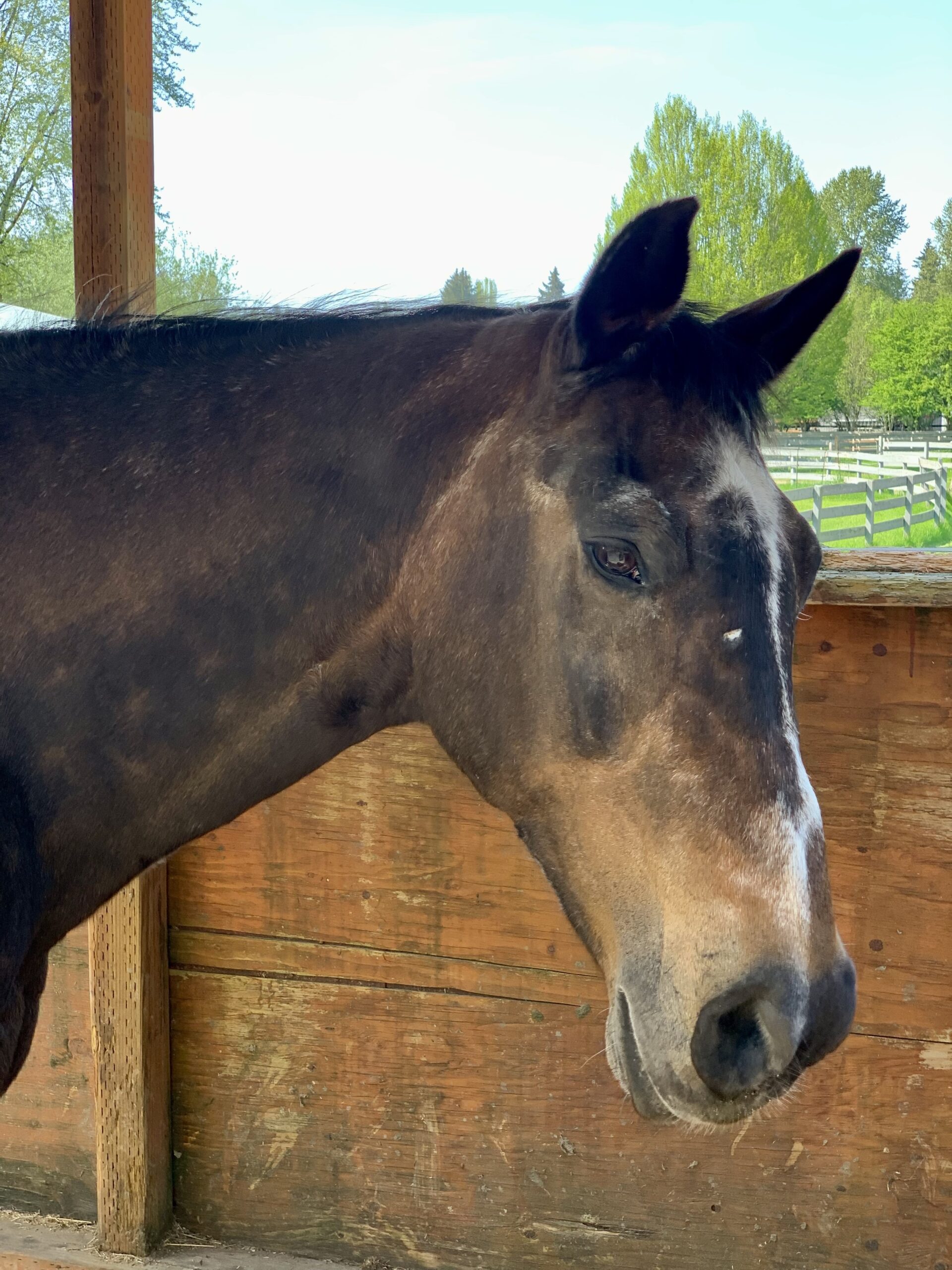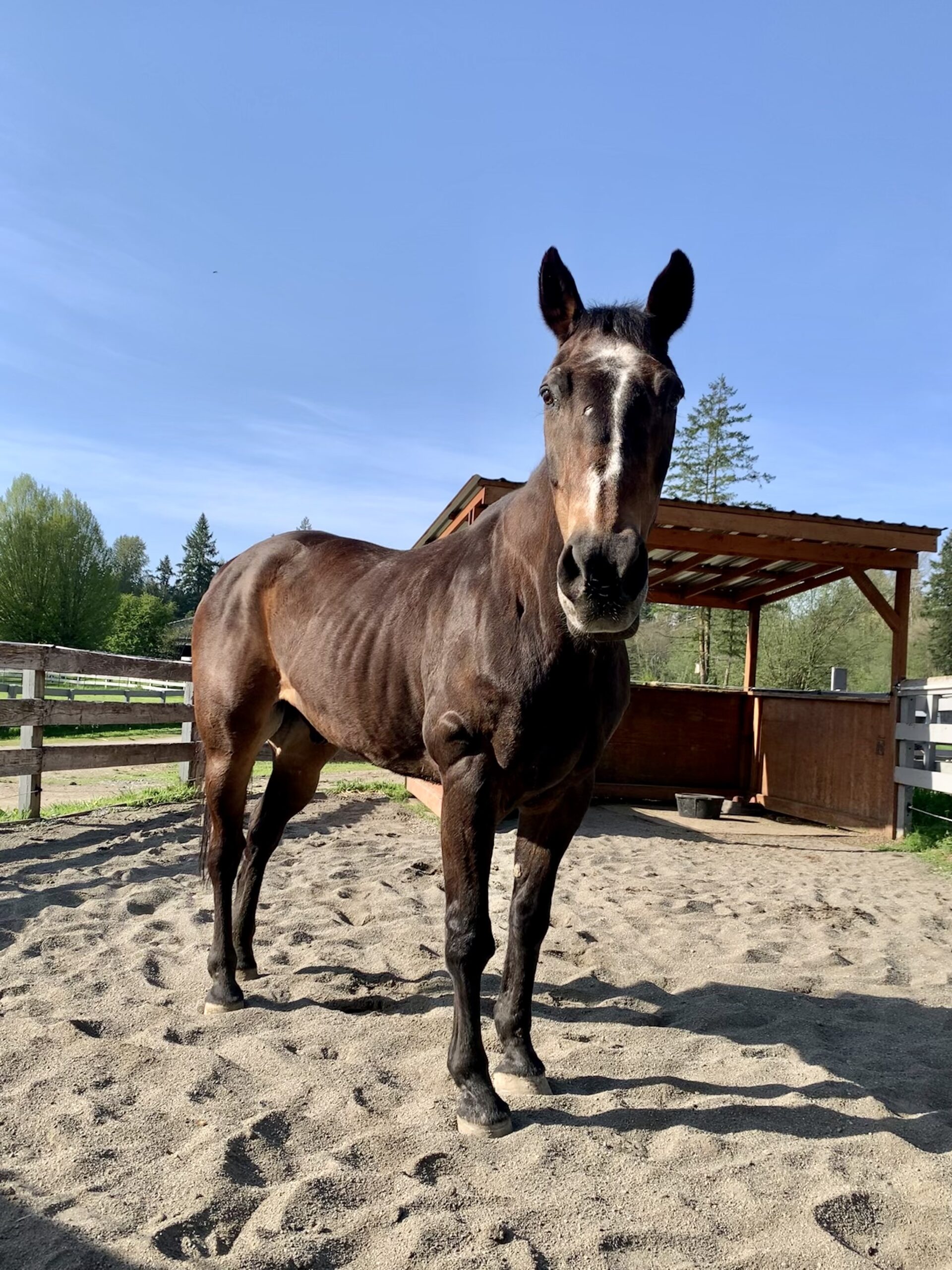Roy
2002 Bay Quarter Horse/Thoroughbred Cross Gelding
Type of Rescue: Animal Control Surrender
Intake Date: 5/1/2023
Date of Death: 5/30/2024
Length of Time with SAFE: 1 year
Roy came to SAFE from a sad situation as part of a herd of 7 horses seized by Pierce County Animal Control officers. Two had to be euthanized on the property, one left the property but was euthanized at the vet hospital, and two others had to be euthanized after a period of time in holding with Animal Control. As such, Roy was a true survivor and experienced a lot of loss before coming to SAFE. Once her arrived at SAFE, it was determined that Roy had a number of medical challenges. In addition to poor teeth that required a special mash diet, Roy had tender feet that did not do well on SAFE’s typical paddock base. We added sand for a cushy footing, and tried glue on shoes but they didn’t stay on very long. Roy was on medication to treat Cushing’s disease, as well as pain medication to add comfort for arthritic joints and his feet. We continuously monitored Roy’s comfort level as well as his other medical conditions with the goal of ensuring that his quality of life stayed at the forefront of his care. Roy enjoyed lots of loving attention for the year he lived at SAFE, but when the decline in Roy’s quality of life became more and more evident, we determined that the kindest way forward to show respect for Roy was to end his struggle.
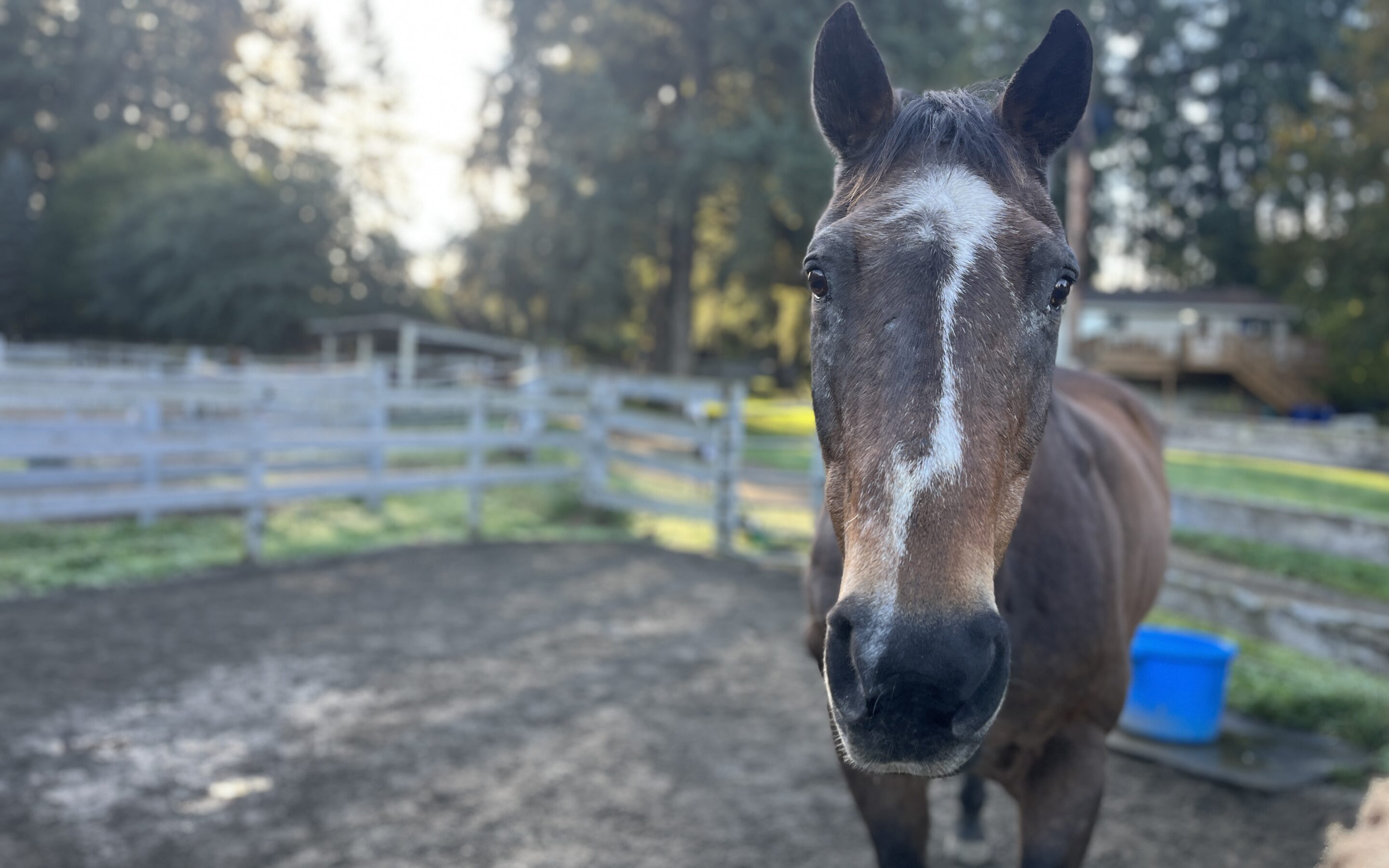
Remembering Roy
Last week, Roy passed peacefully over to join the rest of his herd. A year ago, Roy came to SAFE from a sad situation as part of a 7 horses seizure by Pierce County Animal Control. Two had to be euthanized on the property, one left the property but was euthanized at the vet hospital, and two others had to be euthanized after a period of time in holding with Animal Control. As such, Roy was a true survivor and experienced a lot of loss before coming to SAFE. Even prior to his arrival here, it was determined that Roy had a number of medical challenges. In addition to poor teeth that required a special mash diet, Roy had tender feet that did not do well on SAFE’s typical paddock base. We added sand for a cushy footing, and tried glue on shoes, but they were not sustainable for Roy. He was on medication to treat Cushing’s disease, as well as pain medication to help his arthritic joints and delicate feet. We continuously monitored Roy’s comfort level as well as his other medical conditions with the goal of ensuring that his quality of life stayed at the forefront of his care. Roy enjoyed lots of loving attention for the year he lived at SAFE, earning the title ‘King Roy’ and imprinting himself on many hearts. But when the decline in Roy’s quality of life became more and more evident, we determined that the kindest way forward to show respect for Roy was to end his struggle.
His body may have been beyond our help, but the time spent at SAFE surrounded by great care and immense love, restored his spirit. King Roy, you have left a lasting impression on our hearts, and we were grateful for the time we had to know and love you.
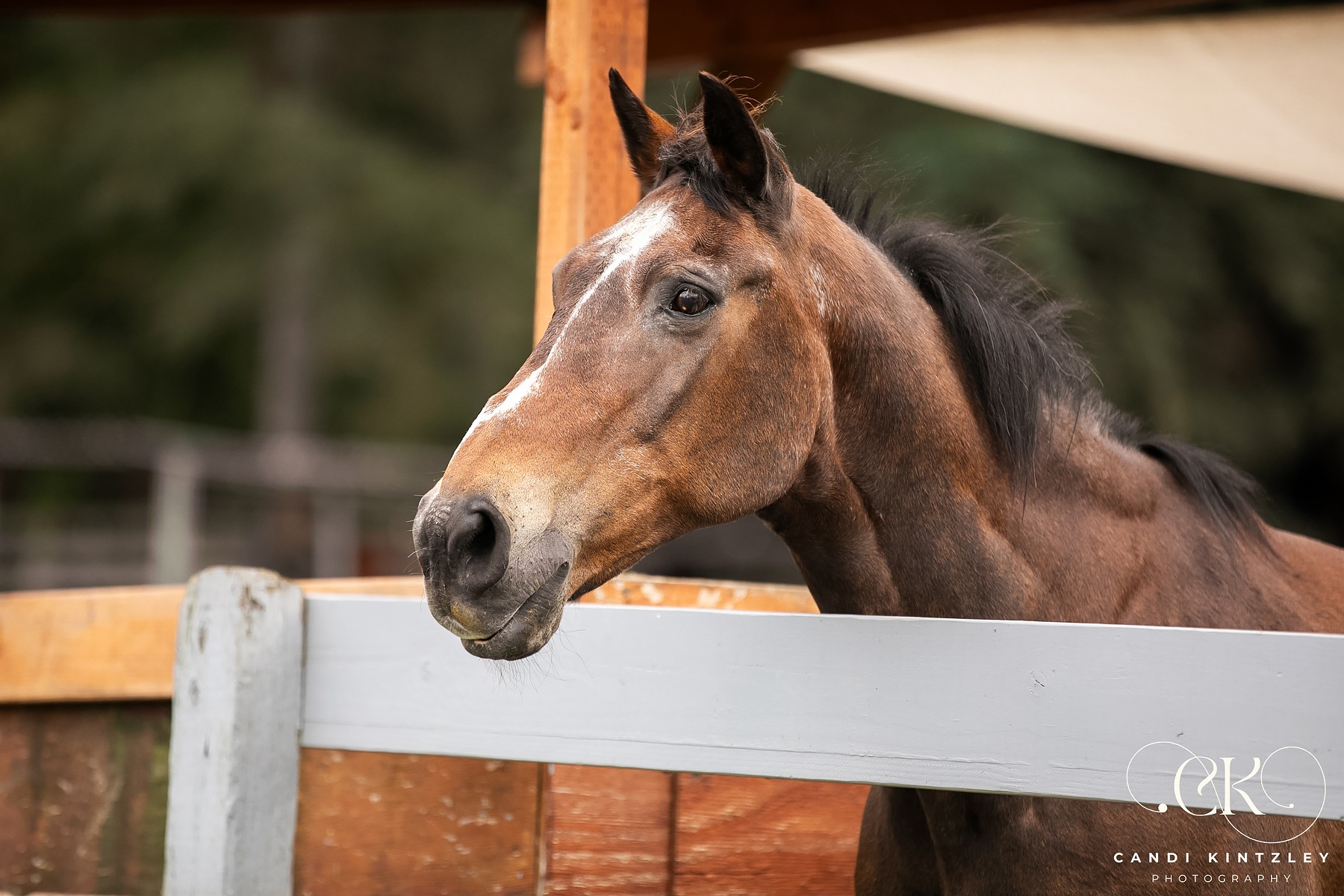
Roy Health Update
It is no secret that Roy has been dealing with various ailments since he first arrived at SAFE, all of which we have been managing, or doing our best to manage. Roy is a very special guy, with special needs, and we keep a close eye on him and give him what comforts we can while he is with us.
Spring and Summer are typically times we look forward to, as these seasons usually portend warm weather and more sunshine. But with the arrival of the sun also come the bugs, which exacerbate Roy’s allergies and bad summer itch. Even with a full coverage fly sheet, bug spray, a twice daily antihistamine, and various creams and salves on the tender spots of his belly and body, we are never able to really get ahead of Roy’s discomfort, only manage it.
The ground hardens in the summer as well, which is hard on Roy’s already delicate feet.
Like previously mentioned, we did have Roy in glue on shoes for several cycles. But it reached the point where it longer sustainable to keep him in them, as he was incredibly difficult to shoe and would often throw one or both far before he was due for his next set. However, the months he was in the shoes did help him build up a level of sole depth that now allows him to be comfortable barefoot, more or less. It would be unwise to have him on anything other than soft footing as to not wear down the sole he worked so hard to develop. Even still, after turnout in the arena with Mirana, he is often sore the next day.
But this is not just a result of the condition of his feet. Roy also has some arthritic changes in his knees, something that most certainly has contributed to how difficult it is for him to lift and hold his feet for the farrier. Roy is currently on daily equioxx for his arthritis, but it can only do so much. Old horses are prone to hock and fetlock sores as is, but Roy’s are especially bad, which is perhaps a testament to how much he struggles getting up. Aside from going down for a roll, Roy is not a horse who sleeps lying down. Recently, he has taken to resting his chin on the ledge of his shelter and dozing off that way.
Roy is also positive for Cushing’s, which is well managed by his daily prascend. This smart boy quickly decided that he did not like the way it tasted, and therefore will refuse any treat we try to bury it in – and trust us, we have tried everything. As a result, we have to syringe it to him each day, which is not the ideal way of administration, but the only thing that works.
Roy’s particular tastes extend to his feed as well. Due to the poor condition of his teeth, Roy’s is a mash-only diet, which he has opinions about. There have been times, plural, when Roy has gone off his food, needing a new combination of senior/haystack, or a different consistency. This can take both him and us several days to figure out, which is hardly ideal. One thing that remains constant, however, is Roy’s love for his alfalfa leaves, which volunteers meticulously sift for him each day to ensure he is only getting the soft chaff.
Roy is a herd-bound horse, which we try our best to manage by keeping his friend close at all times. But there are some instances where she must leave him, which leads to Roy’s distress. Not much can be done to manage Roy’s emotions in these moments, but it is not fun for any of us to experience. But the reality is, with Roy’s delicate feet and unique diet, he is not a candidate to join one of our bigger herds.
But Roy’s life these days is one that befits his station as an old gelding. For the most part, aside from his grooming sessions and trips to the arena for turnout, he spends his days tucked in a corner of his shelter, napping or begging any passersby for a pet on the face. As we come into some drier weather, we have begun turning Roy out with his best friend, Mirana, on the grass.
With a horse like Roy, we remain glued to the present moment, monitoring him closely, and keeping his comfort at the forefront of our minds.
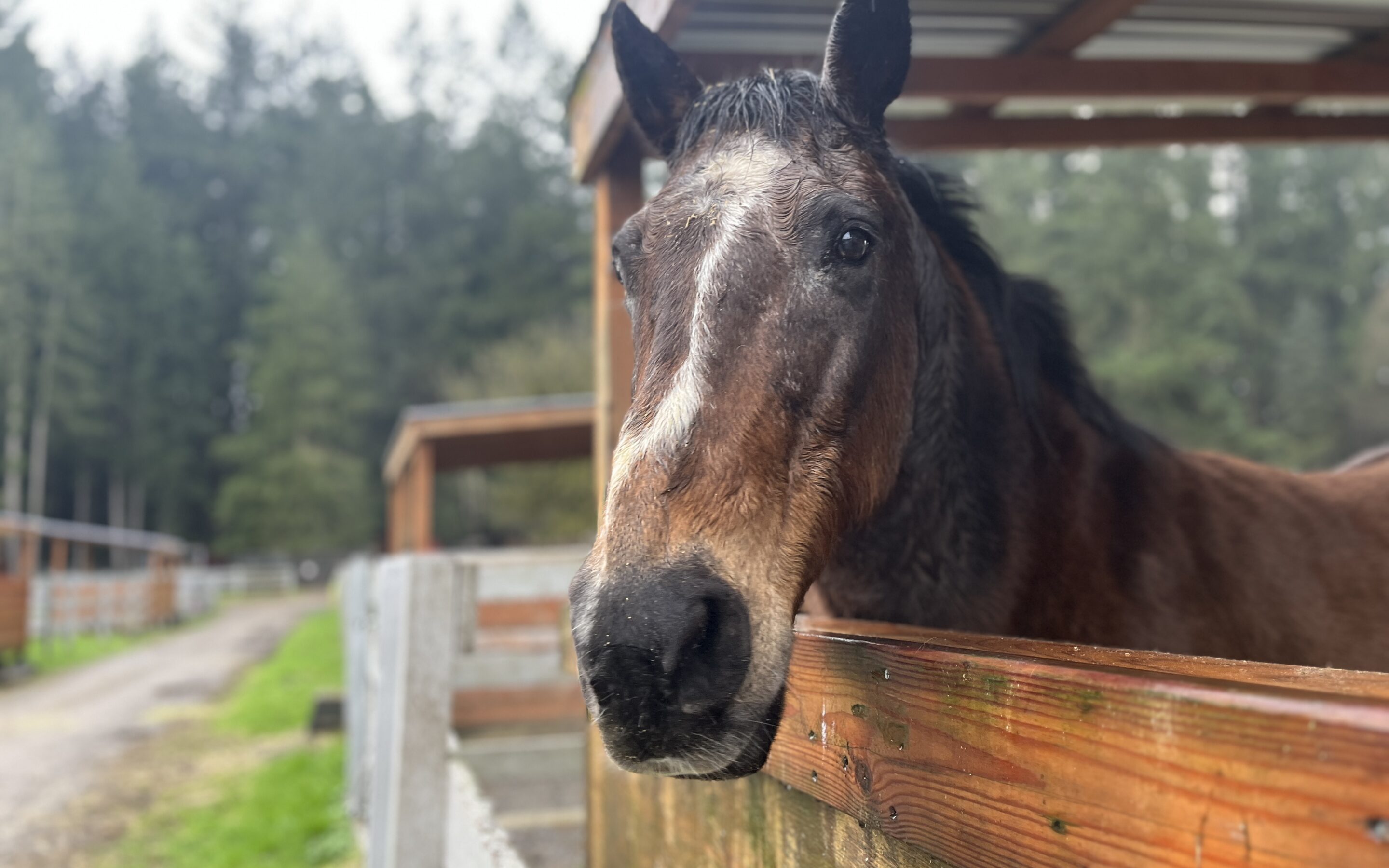
An Update on Roy
After playing in the arena with Mirana this weekend, the next day, Roy was more sore on his feet than he has been in a while. He has been out of glue-on shoes since early January, and has been mostly sound since then (a few off steps here and there, but nothing compared to how he was pre-shoes). Since his first foray into glue-ons, he has grown a lot of sole depth, and our farrier did express that it would be worth trying him out of the shoes to see how he held up without them. This was not only to see if he could exist comfortably barefoot having grown a lot of good foot, but also because some logistical issues were coming into play: Roy is a master of pulling shoes well before the 5 week mark, and his arthritic joints (and, admittedly, tendency towards stubbornness) make standing for shoes something that is quite difficult for all involved parties. As much as our farrier likes us, she was unable to make it out with the frequency needed to keep replacing a thrown shoe. Boots, while a great option, are even more easily shucked by our shoe-dini. Aside from those factors, just one pair of Roy’s shoes cost the equivalent of 5.5 trims. For all these reasons, we are trying Roy barefoot to see if he can keep comfortable that way.
And for the most part, the answer is yes. But after a play session on the soft arena footing, he was noticeably more stiff and uncomfortable. He is on daily equioxx to help his joints.
A survey of his baseline vitals on this post arena turnout day were all in normal range (HR 36, temp 99.1, gut sounds active and present (Roy is a very flatulent guy)), but he did have a digital pulse on his LF.
Roy has also been intermittently off his grain. He is VERY sensitive to environmental factors, and the presence of his neighbors, Theo and Mirana, is basically necessary for him to eat. Still, there are some days when no matter what we do (fresh grain pans, different water concentrations in his mash, etc etc) he simply does not want to eat, even when there is no clear disturbance in the force.
We continue to monitor our sweet old guy daily for changes in his behavior and comfort levels.
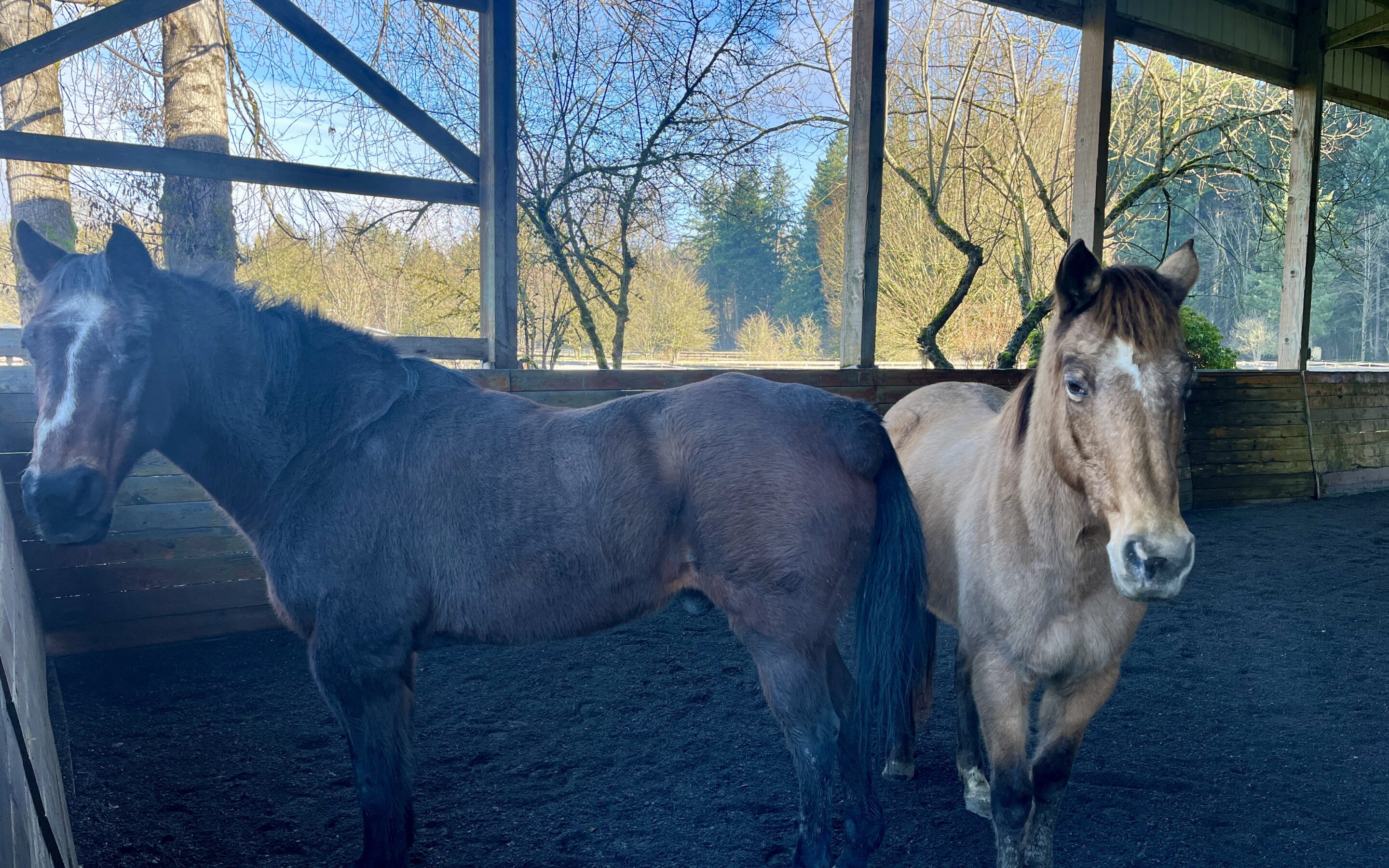
Roy and Mirana’s Arena Time
When we close our pastures for the winter, we switch instead to arena turnout for those horses not in a larger herd paddock. While there may not be grass to much on, the arena has its own list of pleasures, including soft dry sand and a wide open space to run amok in. Roy and Mirana met over grass last summer, and have been neighbor buddies since then (Roy’s grain-only feed situation makes it hard to turn him out to cohabitate with others). But what he can do is enjoy some good arena turnout with his friend Mirana, who also very much enjoys her arena time with Roy. The two walk respectfully to the arena, but as soon as they are let loose, they Let Loose! Roy, for whom arthritic knees and poor feet are constant unwanted companions, kicks up his heels with the best of them when let off the line. And Mirana looks like a filly again as she lopes around the arena. The two typically have a very set schedule when it comes to arena turnout, and it goes something like this:
Stand respectfully while the halter is taken off, but as soon as the humans have fully released, launch out of dodge!
Find a good spot to roll IMMEDIATELY. Extremely crucial step.
Commence rolling. Bonus points if you make it all the way over, but no one’s judging. If you’re Roy: spend a little time itching your belly.
Get up, time to RUN! This can be a long run or a short run, but the burst of energy is highly necessary.
Go stand on the far side of the arena to nap in the sun (if sunny) or just check out what’s goin’ on over there.
Voila! Recipe for successful turnout time!
Watch for yourself these two in action:
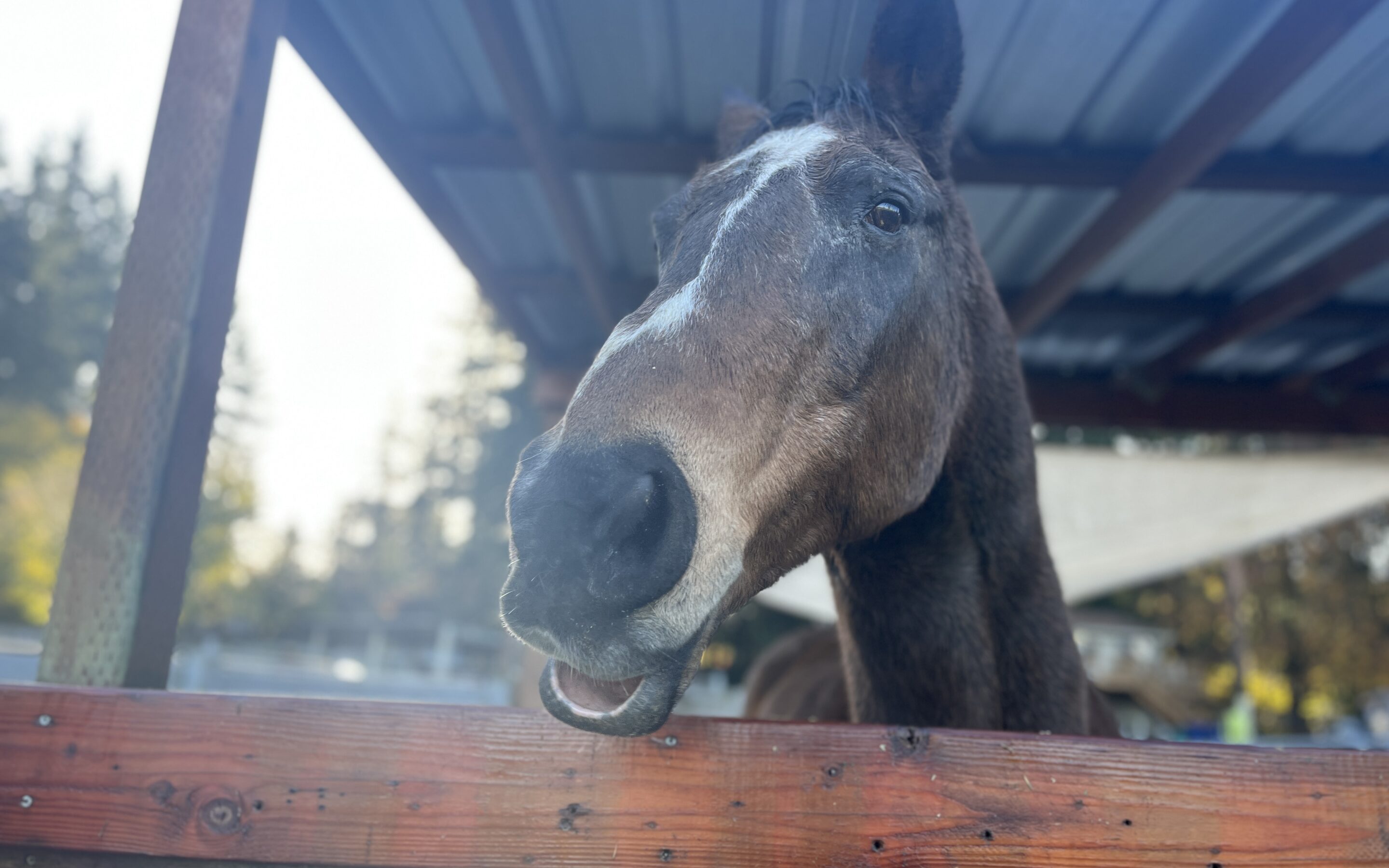
Shoes for Roy
Roy is a special guy. His poor teeth keep him from eating hay, leading him to be on an all-mash diet. He is covered in lumps and bumps (which we think just add a cool topography to his handsome self, but understand how others might find them unseemly). He takes Equioxx every day for his arthritis, and gets a tab of Prascend to manage his Cushing’s. He is prone to sweet itch and insect bite sensitivities. But one of Roy’s major issues have to be his feet. Radiographs taken upon his seizure by Animal Control showed Roy to have both thin soles and rotation, along with ski tipping at the tip of his left coffin bone. Basically, his feet were quite a mess on the inside, and he was showing it from the outside as well. Even the short walk from the trailer into his (sand-filled) paddock was difficult for him. During the summer when he was getting grass turnout, we constructed a walkway of stall mats over the gravel path he took in order to keep him more comfortable on the hard ground, and while this helped, it wasn’t a forever solution. Even in his deeply bedded paddock, Roy would take off steps. “But what about boots?” you’re probably saying. Well, remember that arthritis I mentioned earlier? Because of this, and also his ouchy feet, Roy has a difficult time picking his feet up. Putting boots on him is a challenging endeavor, and he is also somewhat of a Houdini when it comes to being able to shuck them right off.
When consulting with our farrier, she suggested we try him in glue on shoes, a more permanent solution that would hopefully keep him more comfortable for longer. There were a few Roy fans who offered to help cover the cost of his shoes, which was a tremendous kindness. So at his next farrier visit, Roy got a trim and an application of glue on shoes, which he did great for. We offered him a bowl of alfalfa chaff — his favorite — during the process to help distract him from picking up his feet, and it definitely worked. Much like having a mimosa while getting a pedicure, Roy was loving his snack.
Roy is on his second pair of glue-ons now, and doing great! He walks around on all sorts of terrain like any old horse with good feet would, conquering gravel and rocks with hardly an off step. For a guy who looked like he was walking around on broken glass on such surfaces before, this is a huge improvement. We love our handsome, somewhat complicated Roy, and love finding ways to keep him happy!
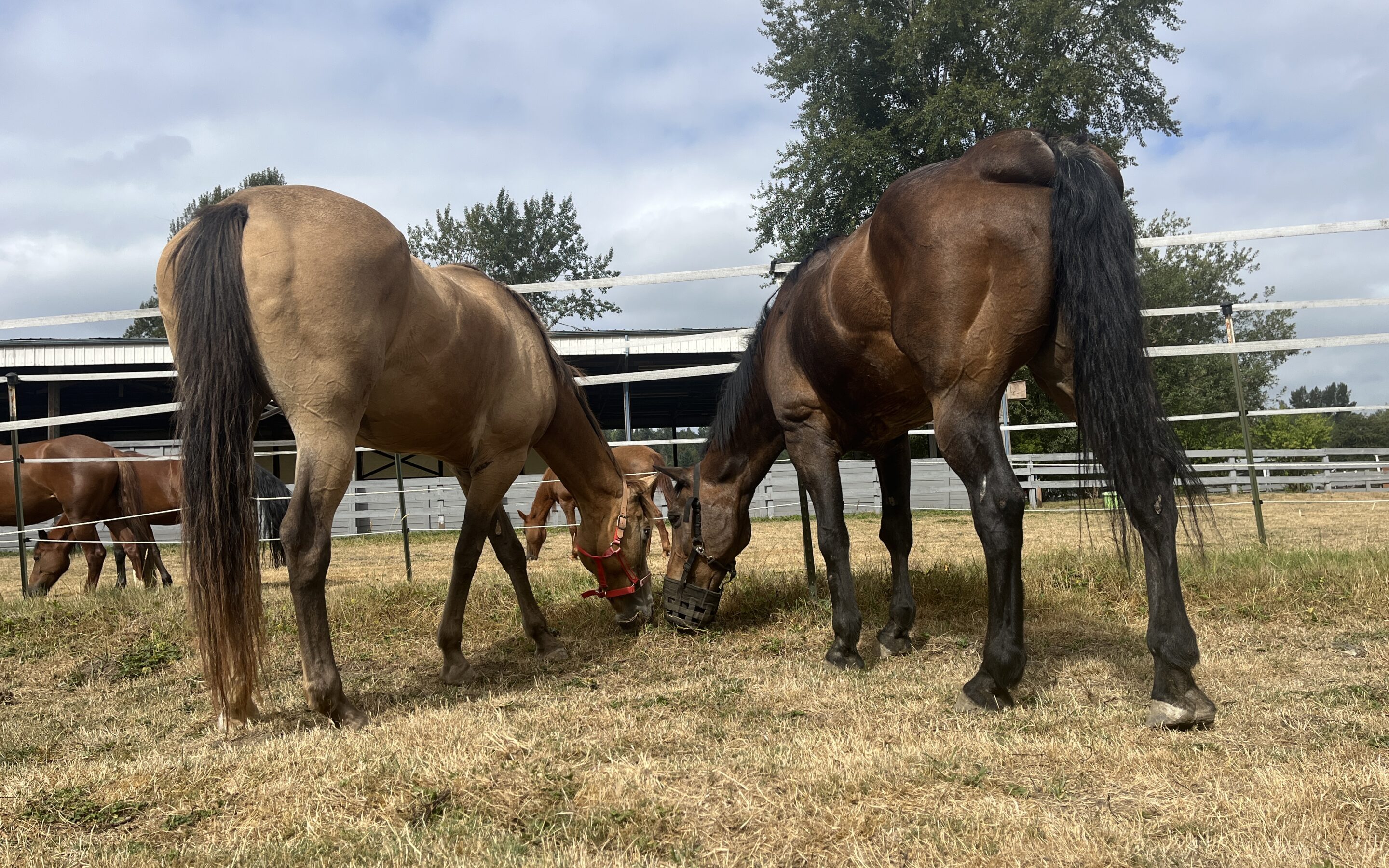
Roy and Mirana, Grazing by a Tree..
If I could add a song to this post, I would probably choose ‘Can You Feel The Love Tonight?’ from a certain loose Hamlet adaptation starring animated lions. It was the first song that sprung to mind when I thought about Roy and Mirana, two horses Of A Certain Age who both were overdue for companionship. While it’s true that no horse at SAFE is ever really alone (even with a double fence line between paddocks, the side yards between horses wouldn’t even be considered a micro-studio by Seattle’s standards), the bachelor pad lifestyle can get old. Unfortunately, there are often roadblocks that get in the way of allowing us to turn out every horse with a buddy.
For a horse like Roy, these roadblocks are numerous.
For starters, Roy is a very tender-footed guy. He has had some hoof events in the past that make his ability to handle anything but the softest of terrains quite ouchy for him. While we explore potential options for his sustained comfort, we have Roy in his own studio apartment of a paddock with soft, cushy sand as flooring. Roy also has bad teeth (if you can even call them that) that makes it risky for him to have access to hay. Roy eats multiple mash meals a day because of this, and a special diet like his means it’s a challenge for him to get turnout with friends.
Apart from his soft sand paddock, the only other footing where Roy is comfortable is on grass. We are able to turn him out this time of year with a grazing muzzle (to add to his list of special needs, Roy also has Cushing’s), and while he does enjoy the time out of his paddock, he would often longingly look towards his neighbors in their herds together.
And then there is Mirana. She had been living in a neighborhood alongside her other cohorts, but it was time for a little restructuring. Mirana’s herdmate, Meadow, had passed away, and Mirana was in need of some company. We moved her across the property, into an empty paddock that just happened to be next to Roy. It was a big change for Mirana, but from across a fence line, Roy did his best to make introductions to his new pretty neighbor. She was not hugely comforted by his presence at the time, but we had a plan.
The next morning, when we turned Roy out in his grass turnout, we put a halter on Mirana as well. It’s nice to make introductions on grass because it adds an element of distraction to an occasionally stressful situation. But we knew Roy had been out with friends in the past, same with Mirana, so we weren’t too concerned when we dropped their halters and let them to their own devices. And what gentle devices they were. There was hardly any reaction whatsoever upon nose sniffing, and the two immediately got to grazing side-by-side, cheek to cheek.
Since that day, the two get together every morning for their daily grass, and when they return to their respective paddocks, they seem comforted by each other, despite the slight separation. It warms our hearts to introduce horses, but especially those who so clearly are seeking companionship.
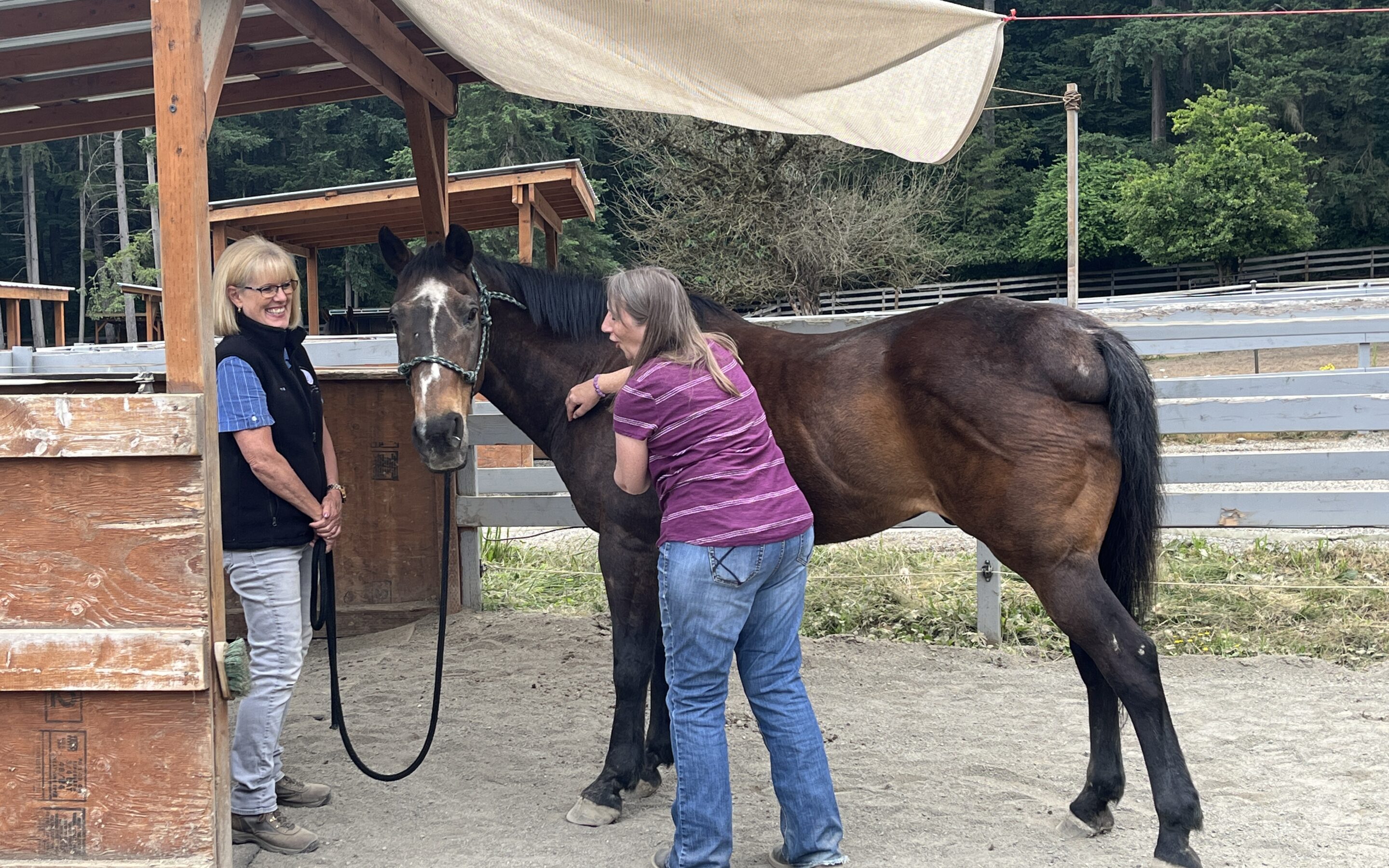
Bodywork with Roy
We are so lucky here at SAFE to have a robust and multi-talented group of volunteers who dedicate their time and talents to help us take the best possible care of our horses. One example of this is, Natalie, a certified practitioner of the Masterson Method bodywork technique, recently performing a session with Roy. Roy is a boy who has been through a great lot in his life, especially recently, so this time spent with Natalie was extra meaningful. Thank you very much to Natalie, and here is what she had to say about their time spent together:
“Today was my first session with Roy. He seemed very standoffish as Trela and I entered the paddock, but we stayed by the gate and waited for him to approach us. Curiosity overcame trepidation and he came over and let us halter him. He has a very quiet way about him and Trela told me his story. I started with gentle bladder meridian technique at light touch and he immediately started to lick and chew.
Roy was very receptive to the Masterson Method — he had many L/C (lick and chew) responses as I explored his neck and poll. He consistently checked in with me and Trela and seemed to take comfort in our presence. I think we became his “herd”.
As I worked around his body, noting various bumps, divots, areas that might be sore or have restriction, Roy took opportunities to move until he found the place HE wanted me to work on, and then would stop and look back to see if I understood. It’s hard as a human to throw away the agenda and follow the horse, but Roy knew what he wanted and we did great work on the neck and withers, and a lot of Hind End points. His main response was lick and chew.
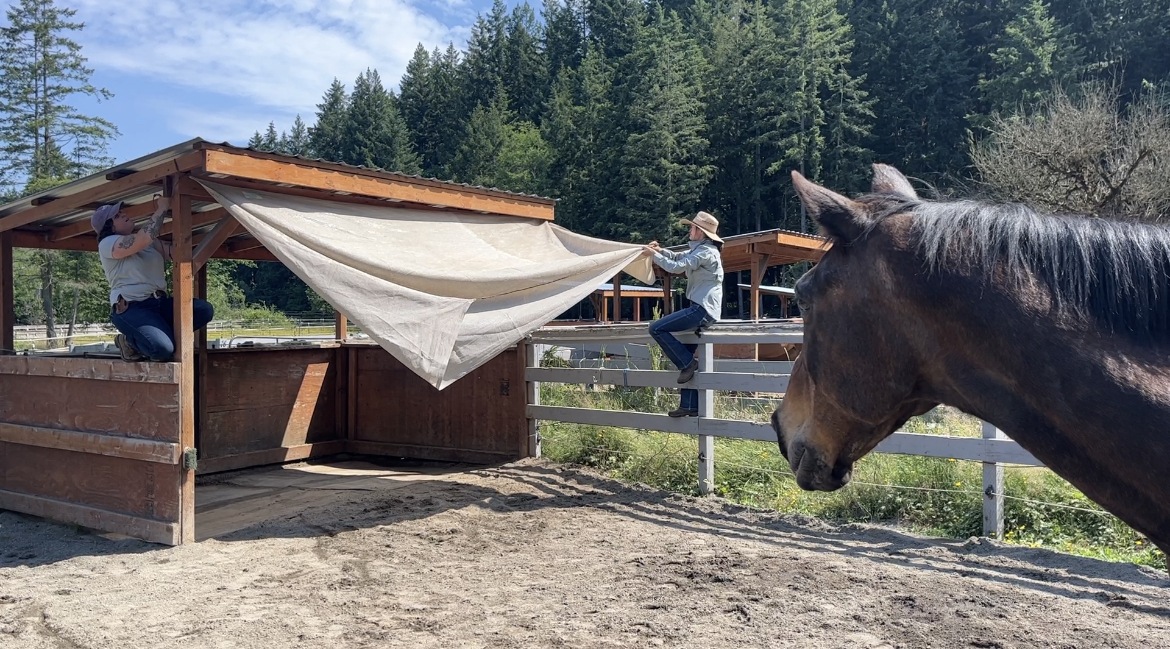
Brave Roy
In my time at SAFE, I’ve learned a thing or two about horses. One of the things I learned is that the majority of them love power tools. If you have to fix a fence or drill in some hardware nearby, even the more timid horses will inquire as to what you are up to. But do you know what horses do not really tend to love? Tarps. Big billowy objects that float and flutter and crackle when stepped on. Terrifying for most.
There are several paddocks that get a fair bit of sun during the months here when the sun is actually out. And when it starts to get hot, the lack of shade in some areas can make it so that we say ‘hey, let’s add some shade here!’ This is typically accomplished by hanging up sun shades, a task that, while slightly tedious for the humans, can be downright terrifying for the horses. A giant tarp? In MY paddock? It’s more likely than you think!
Recently, Roy was the recipient of one such sunshade, and he could not have been cooler (ha) about it. His thoughts on the issue ranged from curious to completely indifferent. He made an excellent supervisor for the project, and as a reward was granted another swath of shade. We captured the moment on video to show you what a chill guy our Roy is!
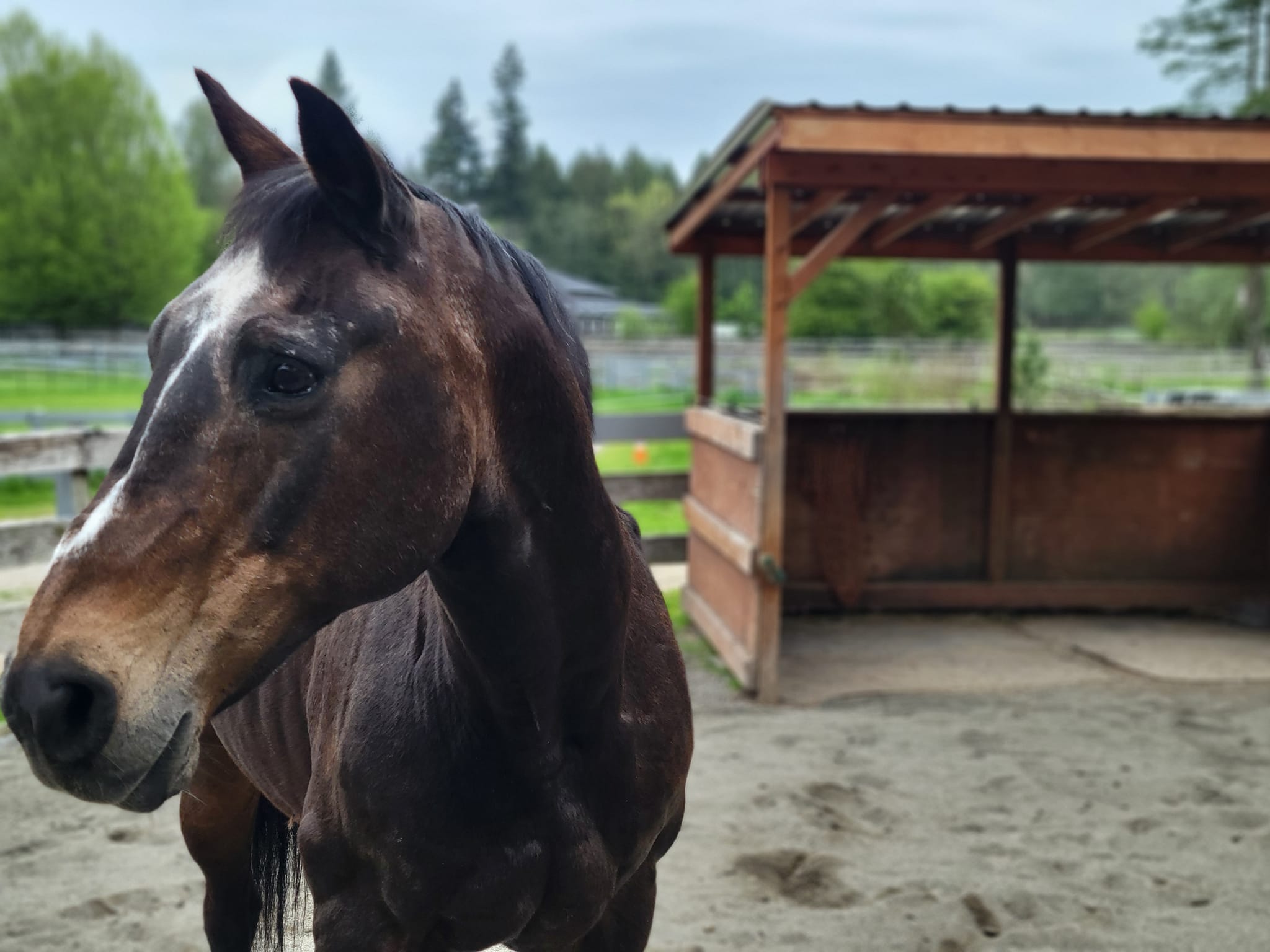
Meet Roy!
At his age his teeth aren’t in the best shape, so he is on a mash diet delivered several times a day, he seems to miss the crunch of hay, so the staff and volunteers sprinkle alfalfa flakes to encourage his appetite. You don’t have to look very closely to notice Roy has very interesting fat pads and lumps all over his body. They have come down since intake due to being on medication to treat Cushing’s.
Before his arrival we knew Roy had sore feet, so we prepared one of our rehab paddocks with a fresh layer of sand. He seemed to be very thankful and upon arrival, pawing at the soft new ground and preforming little hops at the sight of other horses. Roy was very herd bound to his previous buddies, so we look forward to introducing him to a friend once we get him healthy and all settled in.

